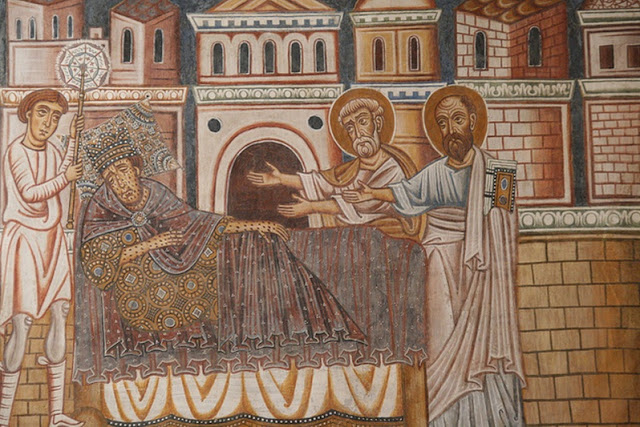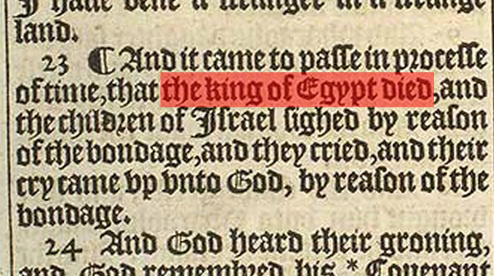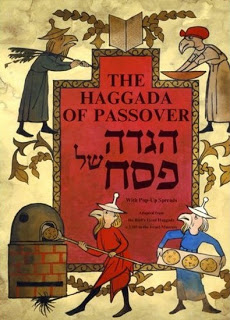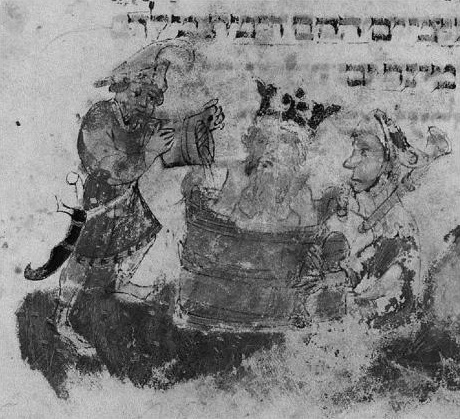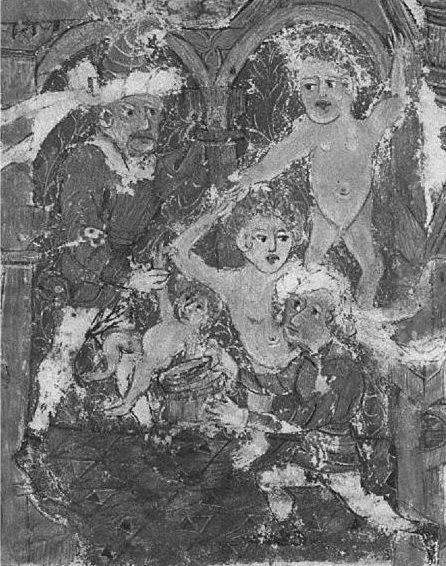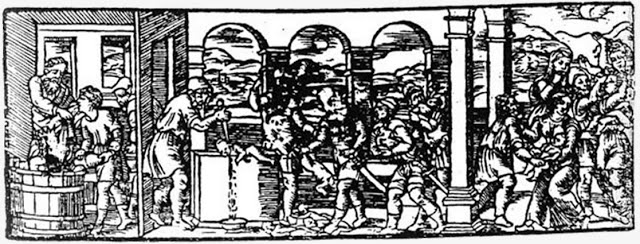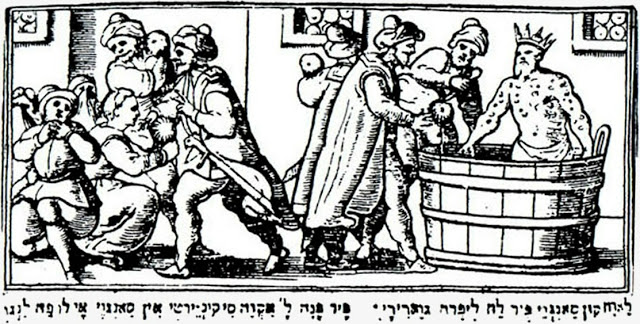[Note: As this is taken from an archived site, some links and videos below may not be working.]
How Jews purloined the bloodbath blood libel
Almost everything in
this post I've learnt from the following three papers listed below.
This is only a brief overview of the Pharaoh's Bloodbath, and I
recommend reading the three cited papers for a fuller view.
Infanticide in Passover
Iconography (1993) by David J. Malkiel. here
Pharaoh's Bloodbath (2009) by Ephraim Shoham-Steiner. here
Sacrifice and Redemption in the Hamburg Miscellany (2012)
by Zsofia Buda. pdf
thru here
This is a depiction of the Roman Emperor Constantine sick with leprosy,
with Saint Peter and Saint Paul who, according to legend, appeared
before Constantine in a dream. It is part of a fresco dated to 1246, in
the Chapel of Saint Sylvester in
Santi
Quattro Coronati, Rome. Photo
source.
The Legenda
Sancti Silvestri (or Actus
Silvestri) which dates between 480—490, is a romanticised (false)
account of Constantine's conversion to Christianity. The Legenda claims
that Constantine had been advised by pagan priests in Rome that the only
cure for his leprosy would be to bathe in the blood of slaughtered
children, but St. Peter and St. Paul appeared to Constantine in a dream
and appealed to him to substitute children's blood for the water of
baptism. The Legenda claims Constantine
submitted to the Saint's request, and was soon baptised by Pope
Sylvester c.312. In reality, Constantine was baptised on his
death-bed in 337 by Bishop
Eusebius.
An
awfully similar legend to Constantine and his prescribed bloodbath,
later appeared in Jewish rabbinism, which, initially at least, also had
a similar happy ending; the bath of children's blood was avoided. But in
later Jewish tradition, the happy ending was dropped and the bloodbath
became a "historical" event.
"For the rabbis,
the Bible is simply an immense metaphor."
— Talmud:
A film by Pierre-Henry Salfati
Rabbinical Jews do not
interpret Exodus 2:23-25 literally.
Although it states "the king of Egypt died", they believed that
it meant 'the king of Egypt caught leprosy, and was advised by his
physicians/necromancers to bathe daily in the blood of 300 Jewish
babies, but God cured him following pleas from the Hebrews.' But as I've
learnt, this story was pilfered from the legend of Constantine's
conversion, and in the Middle Ages it was amended by Ashkenazi Jews into
a more horrific version, where the Pharaoh actually did bathe daily in
the blood of Jewish babies, and it's this version is propagated by
Hasidic Jews to this
day.
The story of the
Pharaoh's bloodbath originates in the Shemot Raba (sometimes Rabbah),
a Midrash, a Rabbinical commentary of the Book of Exodus,
which The Jewish Encyclopedia (Vol
8, 1904, p.562) suggests dates from the 11th or 12th century,
although it also concedes parts of it might be considerably older c.7th
century. The Shemot Raba states of Exodus 2:23-25:
"The king of Egypt
died—he contracted leprosy, and a leper is considered dead ... And the
Children of Yisrael moaned—why did they moan? Because the necromancers
of Egypt told Pharaoh that he had no cure other than to slaughter the
infants of the Children of Yisrael, 150 by evening and 150 by morning,
and to bathe in their blood twice a day. And God remembered His
covenant—our Rabbis teach that a miracle occurred for them, and he was
cured of his leprosy." (Shemos Rabbah 1:35).
As you can see, in the Shemos
Rabbah the bloodbath was avoided, as God cured the Pharaoh, but that
was to change.
The
immensely influential French Rabbi Shlomo Yitzhak, known as Rashi (1040—1105),
whose commentary on the Talmud, has been included in
every single edition of the Talmud for
the last several hundreds years, wrote of Exodus 2:23
in his commentary of
the Tanakh (Jewish Bible):
"The king of
Egypt died—he became a leper [who
is deemed as one dead],
and he used to slaughter Israelite children and bathe in their blood
[as a cure for his disease]."
The Targum
Pseudo-Jonathan,
an Aramaic and paraphrased translation of the Bible, which
might originate from the seventh or eighth century, possibly earlier,
possibly later (12th century). The original no longer exists, and the
only existing "copy" is from the 16th century. It states in Exodus 2:23:
"After a long
time the King of Egypt was afflicted with leprosy, and he ordered
the first-born of the Israelites to be killed so that he might bathe
in their blood."
The Midrash
ha-Gadol (13th century, Yemen) states:
"Pharaoh had
three advisers. When he contracted leprosy, he asked the physicians
what would heal him. Balaam advised him to slaughter the Jews and
bathe in their blood in order to be healed. Job was silent, implying
agreement. Jethro heard and fled. He that advised was killed, he
that was silent was tormented, and he that fled merited the addition
of a letter to his name: it had be Jether [Exodus 4.18], and became
Jethro."
Sefer ha-Yashar (c.13th
century) states:
"When God struck
Pharaoh with disease, he asked his scholars and magicians to heal
him. They said that he would be cured if he put the blood of little
children on the diseased area. Pharaoh accepted this advice, and
sent his attendants to Goshen, to the Israelites, to take their
little children. The attendants went off, and took the Isrelites'
children from their mothers' bosoms by force. They brought them to
Pharaoh each day, one at a time, and the physicians slaughtered them
and applied the blood to the diseased area. They did this every day,
until the number of children slaughtered by Pharaoh reached 375. God
did not heed the Egyptian king's physicians, and the disease grew
stronger. Pharaoh suffered this illness ten years."
I will just mention that many people have claimed over the centuries
that kings of Egypt did bathe in human blood in an attempt to cure
leprosy, and cite as a source the Roman chronicler Pliny the Elder (23AD
- 79AD). Here's precisely what he wrote:
"Aegypti
peculiare hoc malum et, cum in reges incidisset, populis
funebre, quippe in balineis solia temporabantur humano sanguine
ad medicinam eam. et hic quidem morbus celeriter in Italia
restinctus est, sicut et ille, quem gemursam appellavere prisci
inter digitos pedum nascentem, etiam nomine oblitterato."
Natural History,
Volume 26, Chapter 5, Verse
8
"This disease was
originally peculiar to Egypt. Whenever it attacked the kings of that
country, it was attended with peculiarly fatal effects to the
people, it being the practice to temper their sitting-baths with
human blood, for the treatment of the disease." (trans.
by J. Bostock)
In his 2009 paper Pharaoh's
Bloodbath Medieval European Jewish Thoughts about Leprosy Disease and
Blood Therapymore, Dr. Ephraim Shoham-Steiner of Ben Gurion
University of the Nege argues that Jews in the Late Antiquity period,
hijacked the leprous Constantine bloodbath and redemption legend from
the Legenda Sancti Silvestri, and remodelled it in
the Shemot Raba around the Pharaoh, and
the renewed concern the God showed for the Hebrews in Exodus 2:23-25 (which
would lead to their deliverance from Egypt). But, Shoham-Steiner adds:
"by the twelfth and
thirteenth centuries, the Jewish midrashic story supplied by Shemot Raba
no longer served its purpose. Jewish-Christian relations had undergone a
change for the worse. In the aftermath of the 1096 riots and the acts of
infanticide and martyrdom, miraculous deliverance no longer satisfied
Ashkenazi Jews. They wanted revenge for the martyred Jews of the
crusades and other anti-Jewish riots and libels.
The
eschatological ideology of an avenging God that would come and
"settle the score" with Gentiles was by that time not an abstract
notion related to eschaton but a pressing issue. In the minds of
many Jews of the twelfth and thirteenth centuries, the blood of
innocent Jews functioned as a tool to invoke divine wrath in the
final judgment and the subsequent violent retribution towards the
Gentiles who spilled innocent Jewish blood. According to this view,
Pharaoh could not have been healed, innocent Jewish blood had to
be and was spilt, and this blood was an important component in
the process of deliverance; it was to be present before the Lord on
the day of final judgment.
(emphasis in original)
A
Modern
Haggadah based on the earliest known illustrated
Ashkenazi Haggadah
The Haggadah is
a brief overview of the Exodus story, that Jews are supposed to read at
their Passover dinners each and every year. In the 14th
century, Illuminated Haggadah appeared, which are essentially
illustrated Haggadah. The earliest known Ashkenazi Illuminated Haggadah,
is the so-called Bird's Head Haggadah (c.1300), where the illustrated
figures of Jews have bird's faces, and the non-Jews (Pharaoh, Egyptians,
angels, etc.) are depicted with no faces at all. The reason for this was
to circumvent the rabbinical ban on Jewish image making, reminiscent of
the prohibition originating from the Hadith of Sunni Islam, which
forbids all images of not just Mohammad, but all humans, animals, and
angels etc.
Shoham-Steiner
details how the
amending of the hijacked bloodbath legend, from its original
happy-ending (no bloodbaths) to version where the malevolent Pharaoh
regularly bathed in the blood of Jewish youths, is evident in the
Illustrated Haggadah of the 14th and 15th century.
Illustrations
on "folio 15V" (full
page here)
from the Bird's Head Haggadah
Shoham-Steiner
describes how the image on the right "the
binding of Isaac" on the Bird's Head Haggadah (c.1300), was replaced
on later 15th century Haggadahs with images of the Pharaoh sitting in a
bloodbath, and of Egyptians slaughtering infants for his bath.
Shoham-Steniner suggests that Ashkenazi Jews were "too intimidated
to present an image or a scene that might have implicated them as those
who slaughter rather than those who are slain." He
writes:
"The difference
is significant, for aside from its polemical meaning, the Binding of
Isaac signifies, probably more than any other scene from Genesis or
the entire Hebrew Bible, the concept of the merit of the Patriarchs.
It represents the ultimate sacrifice on the part of the two
Patriarchs involved. In late antiquity, as well as in the Middle
Ages, Jews saw the Binding of Isaac as the constituent core of the
Patriarchs' merit, the act that resonates far beyond the Patriarchs
to their immediate kin—the Children of Israel—enabling Jews to make
the most of this extreme gesture of ultimate faith in God.
Interestingly, this is the exact theme that Ashkenazi Jews had
altered when they deviated from the Shemot Raba tradition. In their
minds, the blood of innocent children designed to heal Pharaoh's
leprosy was spilt and that blood symbolically harbored the
redemptive qualities they saw in their own blood spilt during riots
and libels."
Shoham-Steiner cites
"the Nuremberg Haggadah" as an example of how the Binding of Isaac was
replaced by the Pharaoh's Bloodbath. There is the First Nuremberg
Haggadah (c.1449) and the Second Nuremberg Haggadah
(1450-1500), the First is
not available online, but the Second is
viewable through this
link (you'll
need DjVu), and a full description and translation is viewable on this pdf from
the National Library of Israel. Below are images from page
14 of
the Second
Nuremberg Haggadah,
and the captions are quoted from the aforementioned description
available from the National Library of Israel.
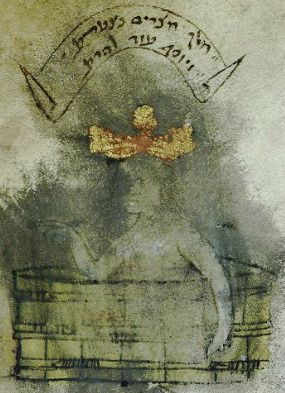 |
"In the outer margin, crowned Pharaoh is sitting naked in a bathtub,
possibly full with blood."
"Inscribed above Pharaoh:
עוד להרע." נצטרע/ ויוס מצרי "מל
(The king of Egypt became leprous, and he became even more evil)" |
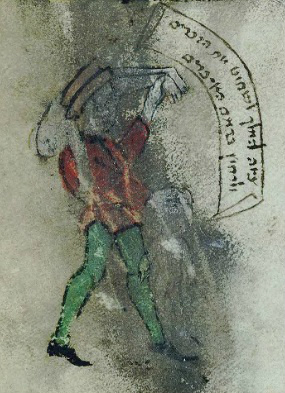 |
|
"Below, an Egyptian is carrying
the corpses of children (badly damaged)"
"Above the Egyptian is
inscribed:
האיברי בדמ " / ולרחו לשחוט את
הזכרי "ציוה המל
(The king ordered the males to
be slaughtered, and his limbs to be washed in their blood)"
|
Below are other images
of the Pharaoh's bloodbath mostly from Haggadahs
created between 1427 and
1690, but also one from a Hebrew prayer book:
This images and the one
immediately above it, are from the same page
(folio 13) of the Yahuda Haggadah (c.1450).
The top image depicts the Pharaoh sitting in his bloodbath, the other
shows a man swinging a cleaver at a infant, whilst another man has two
infants impaled on a spear slung over his shoulder, and an infant
grasped in left hand. A corpse of an infant lays on the floor between
the two men.
The two images
immediately above are from a Haggadah found in the so-called Hamburg
Miscellany a collection of Hebrew documents (c. 1427").
Once again the Pharaoh is depicted in his bloodbath, and beneath, two of
lackeys are shown with three Jewish children and a bucket to collect
their blood to fill the Pharaoh's bath.
This image of the
Pharaoh in his bloodbath
Mantua Haggadah, 1560
Second Prague Haggadah, c.1580
Venice Haggadah, 1609
The four images above are reproduced from Ariel Toaff's
Blood
Passover
------------------------------
"When a Jew, in America or in South Africa, talks to
his Jewish companions about 'our' government, he means the
government of Israel."
- David Ben-Gurion, Israeli Prime Minister

Viva Palestina!
Latest Additions
- in English
What is this Jewish
carnage
really about? - The background to
atrocities
Videos on Farrakhan, the Nation of Islam and Blacks and Jews

How Jewish Films and Television Promotes bias Against
Muslims
Judaism is Nobody's
Friend
Judaism is the Jews' strategy to
dominate non-Jews.
Jewish War Against
Lebanon!
Islam and Revolution
By Ahmed Rami
Hasbara -
The Jewish manual
for media deceptions
Celebrities bowing to their Jewish masters

Elie Wiesel - A Prominent False Witness
By Robert Faurisson
The Gaza atrocity 2008-2009

Iraq - war and occupation
Jewish War On
Syria!
CNN's Jewish version of "diversity"
- Lists the main Jewish agents
Hezbollah the Beautiful
Americans, where is your own Hezbollah?
Black Muslim leader Louis Farrakhan's Epic Speech in Madison Square
Garden, New York
 - A must see!
- A must see!
"War on Terror" -
on Israel's behalf!
World Jewish Congress: Billionaires, Oligarchs, Global Influencers for Israel
Interview with anti-Zionist veteran Ahmed Rami of Radio Islam
- On ISIS, "Neo-Nazis", Syria, Judaism, Islam, Russia...
Britain under Jewish
occupation!

Jewish World Power
West Europe
East Europe
Americas
Asia
Middle East
Africa
U.N.
E.U.
The Internet and
Israeli-Jewish infiltration/manipulations
Books
- Important collection of titles
The Judaization of
China
Israel: Jewish Supremacy in Action
- By David Duke
The Power of Jews in France
Jew Goldstone appointed by UN to investigate War Crimes in Gaza

The best book on Jewish Power
The Israel Lobby
- From the book
Jews and Crime - The archive
Sayanim - Israel's and Mossad's Jewish helpers abroad
Listen to Louis Farrakhan's Speech
- A must hear!
The Israeli Nuclear Threat
The "Six
Million" Myth
"Jewish History"
- a bookreview
Putin and the
Jews of Russia
Israel's attack on US warship USS Liberty
- Massacre in the Mediterranean
Jewish "Religion" - What is
it?
Medias
in the hands of racists
Strauss-Kahn - IMF chief and member of Israel lobby group

Stop Jewish Apartheid!
The Jews behind Islamophobia
Israel controls U.S. Presidents
Biden, Trump, Obama, Bush, Clinton...
The Victories of Revisionism
By Professor Robert Faurisson
The Jewish hand behind Internet
The Jews behind Google, Facebook, Wikipedia,
Yahoo!, MySpace, eBay...
"Jews, who want to be decent human beings, have to renounce being Jewish"
Jewish War Against Iran
Jewish Manipulation of World Leaders

Al Jazeera English under
Jewish infiltration

Garaudy's "The Founding
Myths
of Israeli Politics"
Jewish hate against Christians
By Prof. Israel Shahak
Introduction to Revisionist
Thought
- By Ernst Zündel
Karl Marx: The Jewish Question
Reel Bad Arabs
- Revealing the racist Jewish Hollywood propaganda
"Anti-Semitism" - What is it?
Videos
 - Important collection
- Important collection
The Jews Banished 47 Times in 1000 Years - Why?
Zionist
strategies
- Plotting invasions, formenting civil wars, interreligious strife,
stoking racial hatreds and race war
The International Jew
By Henry Ford
Pravda interviews Ahmed Rami

Shahak's
"Jewish History,
Jewish Religion"
The Jewish plan to destroy the Arab countries
- From the World Zionist Organization
Judaism and Zionism inseparable
Revealing photos of the Jews 
Horrors of ISIS Created by Zionist Supremacy
- By David Duke
Racist Jewish Fundamentalism
The Freedom Fighters:
 Hezbollah
- Lebanon
Hezbollah
- Lebanon
 Nation of Islam
- U.S.A.
Nation of Islam
- U.S.A.
Jewish Influence in America

- Government, Media, Finance...
"Jews" from
Khazaria stealing the land of Palestine
The U.S. cost of supporting Israel
Turkey, Ataturk and
the Jews

The truth about the Talmud
Israel and the Ongoing Holocaust in Congo
Jews DO control the media -
a Jew brags!
- Revealing Jewish article
Abbas - The Traitor
Protocols of Zion
- The whole book!

Encyclopedia of the
Palestine Problem
The
"Holocaust" - 120 Questions and Answers
Quotes
- On Jewish Power / Zionism
Caricatures / Cartoons

Activism!
- Join the Fight!


























